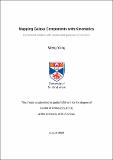Files in this item
Mapping galaxy components with kinematics : dynamical models with stellar and gaseous kinematics
Item metadata
| dc.contributor.advisor | Weijmans, Anne-Marie | |
| dc.contributor.author | Yang, Meng | |
| dc.coverage.spatial | [xxii], 167, [16] p. | en_US |
| dc.date.accessioned | 2021-02-23T16:00:10Z | |
| dc.date.available | 2021-02-23T16:00:10Z | |
| dc.date.issued | 2020-12-01 | |
| dc.identifier.uri | https://hdl.handle.net/10023/21492 | |
| dc.description.abstract | Mapping galaxy mass distribution is an important means of understanding galaxy morphology and the nature of dark matter haloes, and therefore build up our knowledge of galaxy formation and evolution. Analytical and numerical dynamical models are powerful methods to model galaxy mass distributions based on galaxy stellar kinematics, and are strengthened by including gaseous kinematics. In this thesis, I start my research with using descriptive analytical models to identify thin-disc components in galaxies. I kinematically classify the sample into disc-dominated, non-disc-dominated and disc-free galaxies and measure the dynamical mass for disc-dominated galaxies to study their mass budget. I find a dichotomy of lenticular galaxies in my classification, which is explained by the deficiency of molecular gas. Realising the limitation of analytical models, I continue my research with numerical models. I develop an orbit-based method with stellar kinematics modelled by the Schwarzschild technique, and cold gas (H I ) assumed as a thin disc aligned with stars. The application of this method to early-type galaxy NGC 2974 shows that including extended cold gas kinematics significantly narrows down the measurement of the dark matter inner slope. I then further generalise this method to be adapted for galaxies with misaligned stellar and gas discs and apply the generalised method to early-type NGC 3626. The results suggest that with very extended cold gas discs out to 10 Rₑ, there is a chance to determine the overall shape of dark matter halo and even distinguish between different halo models. I finally model a larger sample of galaxies which have two-aperture stellar kinematics using the Schwarzschild technique to study their orbital components and dark matter profiles across a wider mass range. The dark matter fraction is typically 40%-70% at 3 Rₑ, and I find no clear trends between the dark matter fraction and stellar mass. | en_US |
| dc.description.sponsorship | "My postgraduate study was supported by the China Scholarship Council [File No. 201603780010]. My research in this thesis received grant from the Scottish Universities Physics Alliance [Postdoctoral and Early Career Researcher Exchange Program]; the Royal Astronomical Society [RAS Small Grants Scheme]; and the International Astronomical Union [IAU Symposium No. 353]." -- Funding | en |
| dc.language.iso | en | en_US |
| dc.publisher | University of St Andrews | |
| dc.relation | An analytical model to identify thin discs in MaNGA galaxies (thesis data) Yang, M., University of St Andrews, 24 July 2020. DOI: https://doi.org/10.17630/71cd0f94-5758-4fcc-8e68-fdcd0ff19f7d | en |
| dc.relation.uri | https://doi.org/10.17630/71cd0f94-5758-4fcc-8e68-fdcd0ff19f7d | |
| dc.title | Mapping galaxy components with kinematics : dynamical models with stellar and gaseous kinematics | en_US |
| dc.type | Thesis | en_US |
| dc.contributor.sponsor | China Scholarship Council (CSC) | en_US |
| dc.contributor.sponsor | Scottish Universities Physics Alliance (SUPA) | en_US |
| dc.contributor.sponsor | Royal Astronomical Society (RAS) | en_US |
| dc.contributor.sponsor | International Astronomical Union. Symposium (353rd : 2019 : Shanghai, China) | en_US |
| dc.type.qualificationlevel | Doctoral | en_US |
| dc.type.qualificationname | PhD Doctor of Philosophy | en_US |
| dc.publisher.institution | The University of St Andrews | en_US |
| dc.identifier.doi | https://doi.org/10.17630/sta/32 | |
| dc.identifier.grantnumber | 201603780010 | en_US |
This item appears in the following Collection(s)
Items in the St Andrews Research Repository are protected by copyright, with all rights reserved, unless otherwise indicated.

